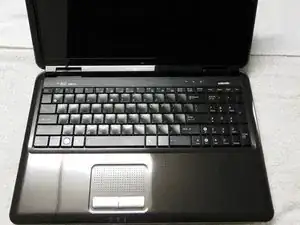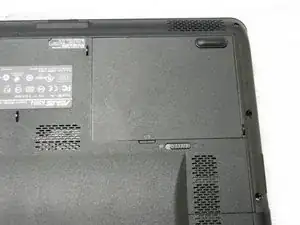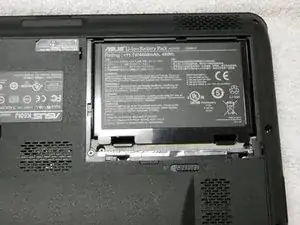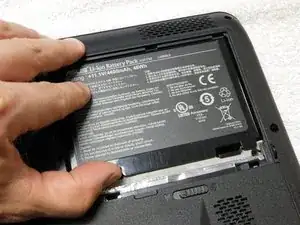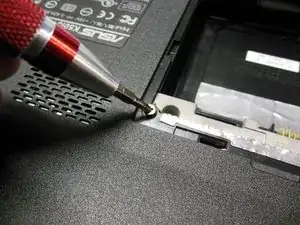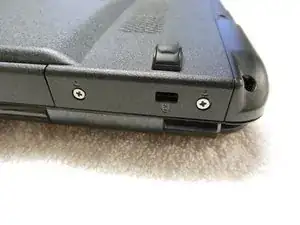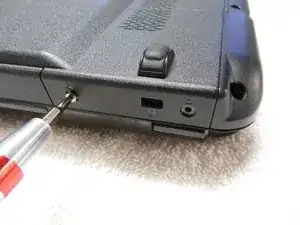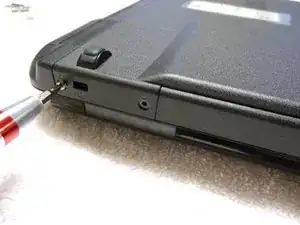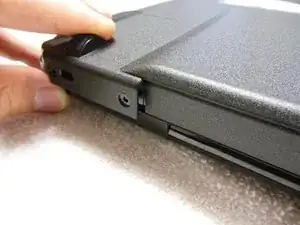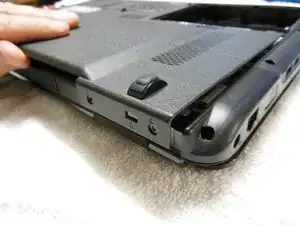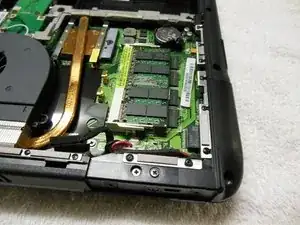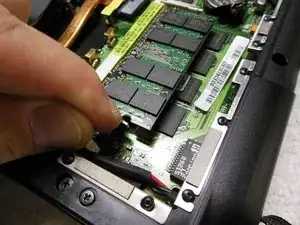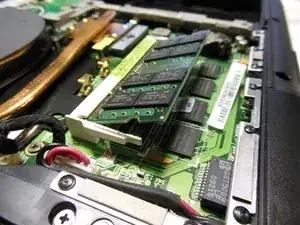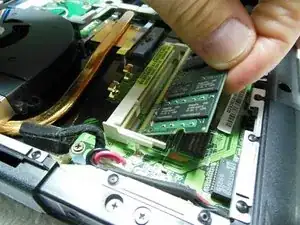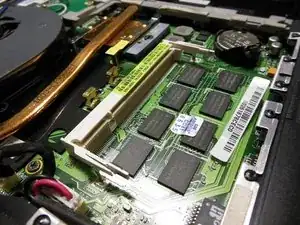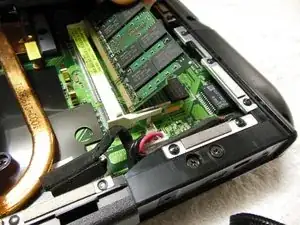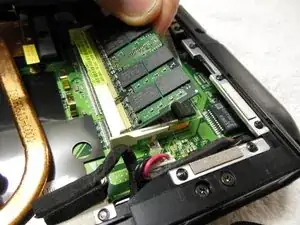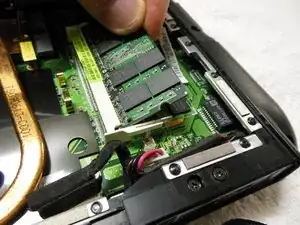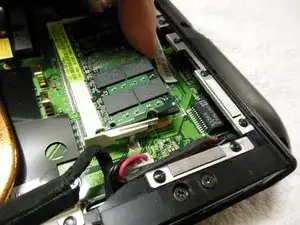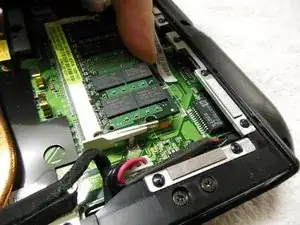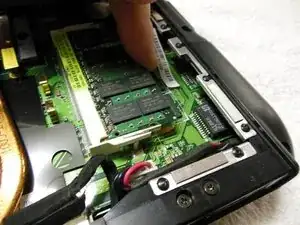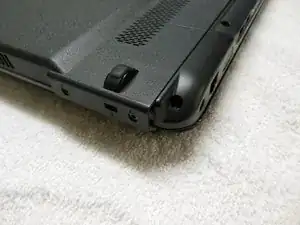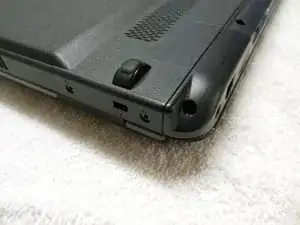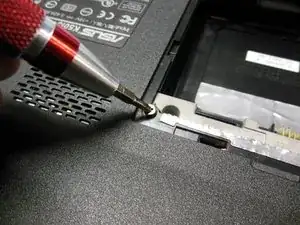Einleitung
I am going to teach you how to upgrade your ASUS K50IJ. To start with it, it is not that hard! The only tools you need is a small Phillips screwdriver, a towel, and courage!
Werkzeuge
Ersatzteile
-
-
Turn the laptop on its back, with the battery compartment on the top right.
-
Put the laptop on a towel to avoid any scratches.
-
-
-
Open the battery compartment. Store the lid at a safe place.
-
The battery is held by two holding clamps.
-
Push these holding clamps toward the battery at the same time. When pushed, lift the battery out of its compartment
-
Remove the screw that holds the bottom piece of the laptop and store it in a safe place.
-
-
-
Besides the screw already removed, the bottom piece is held by four other screws.
-
Remove the screws on the right sight as the picture shows.
-
Now remove the two other screws on the left side of the laptop.
-
-
-
The bottom piece is now loose. However, it still needs to be pulled out slightly, about 1/4 of an inch.
-
Now lift it up and put it at a safe place.
-
-
-
On the right lower side you can see the memory. The ASUS K50IJ has 2GB memory on board and usually comes with a 1GB memory stick (=3GB total RAM memory). The laptop can be upgraded to 4GB maximum, which means you can only use a 2GB stick (2GB PC2-6400 DDR2).
-
The memory stick is fixed with two holding clamps. Before you push these clamps aside, be sure that you are not electrostatic (go to the kitchen sink and touch the metal faucet to be discharged).
-
Now first push one holding clamp away from the memory stick. The stick will slightly pop up since it is under tension. Now push the other holding clamp, too.
-
-
-
In this position, the memory stick is now ready to be removed. Use one hand and pull it out of the slot.
-
While you are pulling it out of the slot, don't push it down. Pull it out in the same angle as it is (if you push it down, you will just re-fix the stick in the slot and might break a pin of the holder).
-
-
-
Take the new stick and carefully put it into the slot in the same angle you removed the old one.
-
Slightly push it into the slot holder (keep the angle). When all of the golden pins disappeared, the memory stick is ready to be pushed down back into the two holding clamps.
-
-
-
While slighty pushing toward the slot holder, use your pointer finger and push down the memory stick until you hear a click.
-
The click indicates that the memory stick snapped into place. However, double check that the stick has latched into both holding clamps. If necessary, push on one side where the stick has not latched yet.
-
-
-
Put the bottom part back onto the laptop as shown. Then push it slightly back to its original position.
-
Pay attention that the bottom piece engages well and evenly.
-
Take the four screws (2 for each side) and fix the bottom piece.
-
Take the screw you removed near the battery compartment and screw it in.
-
Take the battery and put it back into the compartment.
-
Take the lid of the battery compartment and close it. That's it!
-
9 Kommentare
hi sir i installed that same memory stick pc2-6400, but laptop is not recognizing it! ON SAME COMPUTER! what do i have to do? email javierortega72@gmail.com! ty for ur post and help!
I installed 4GB module and it is reporting 6GB total running fine on Win 8.1 x64!
Hola! de que marca y modelo le pusiste el modulo de 4Gb?
Yo le puse un HD Hibrido Seagate SDD Laptop (1THD +8GB HDD) de 1T y duplico la velocidad de la maquina!!!!
Jorge -
LOL .. So the sistem can see more the 4 GB like they say on the site ?
SoLL -
Hello, TB1979—
Your installation of a single 4GB SODIMM module with good results encourages me to try, as well.
To ensure I match your procedure, what is the specification of your DDR2 memory module? That is, the “speed” (667 or 800 mhz) and memory timing (usually 5-5-5-15/18). You probably used PC-5300, but I wanted to be sure.
It also would help to have a link to the seller and/or phone, if available.
Many thanks for your posted message— I’ll reply with my results.
If you installed 4GB and Windows is reporting that you have 3GB or less, it is typically due to the fact that you have a 32 bit version of Windows installed. 32 bit versions of Windows can only address 3GB of memory. You will have to upgrade your operating system to a 64 bit version. If your laptop is not detecting it at all, i.e. does not even appear in the bios setup utility, then most likely you have exceeded the maximum amount of ram supported by your hardware. If not, the next most likely cause is a faulty memory module. Try another memory module.
